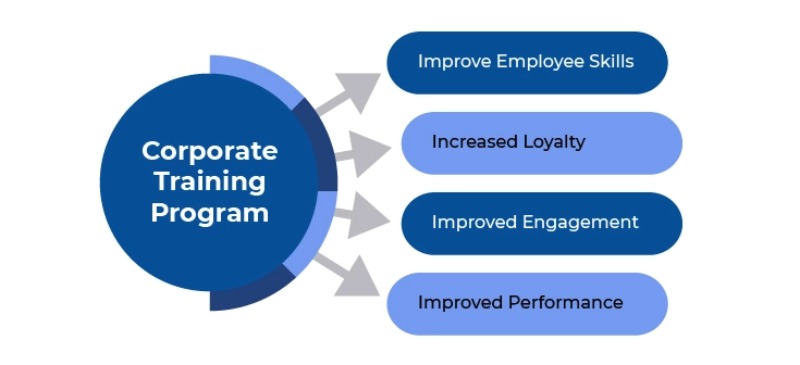In today’s fast-paced corporate world, businesses need to continuously adapt to remain competitive. One of the most effective ways to foster employee growth and ensure long-term business success is through corporate training programs. These structured programs provide employees with the skills, knowledge, and tools they need to perform at their best while contributing to the overall success of the company.
What are corporate training programs?
Corporate training programs refer to organized courses or workshops designed specifically to meet the development needs of employees within an organization. These programs cover a wide range of topics, from technical skills to soft skills, and aim to enhance individual capabilities while aligning with the company’s objectives. Whether it’s onboarding new hires or upskilling current employees, corporate training is an essential investment that businesses make to build a stronger workforce.
The goal of these programs is twofold: to improve employee performance and ensure that the organization remains agile in the face of market changes. By focusing on continuous learning and development, companies can create a culture that values growth and innovation.
Benefits of corporate training programs for businesses
Corporate training programs bring a host of benefits not only to employees but also to the company as a whole. These programs lead to enhanced performance, better employee engagement, and the development of future leaders.
Enhancing work performance
One of the primary goals of corporate training programs is to improve the overall work performance of employees. A well-trained workforce can handle tasks more efficiently and solve complex problems more effectively. Training programs allow employees to acquire new skills and apply them to real-world situations, leading to:
- Increased productivity: Employees who receive proper training are better equipped to handle their responsibilities, which can lead to higher output and better quality of work.
- Reduced errors and delays: Well-trained employees are less likely to make mistakes, resulting in smoother workflows and fewer disruptions in operations.
Improving employee engagement
Corporate training programs play a significant role in boosting employee morale and engagement. When employees feel that their company is investing in their growth, they are more likely to feel valued and committed to the organization. Benefits of improved engagement through training include:
- Higher job satisfaction: Employees who are continuously learning and growing in their roles feel more fulfilled and are more likely to remain with the company.
- Stronger retention rates: Offering training and development opportunities can help retain top talent, reducing turnover rates and the costs associated with hiring and onboarding new employees.
Developing future leaders
Leadership development is another key component of corporate training programs. By offering leadership training, companies can identify and nurture future leaders within their ranks, ensuring smooth succession planning. The benefits of leadership development include:
- Creating a talent pipeline: Companies can prepare employees for future leadership roles, ensuring that there is always a ready pool of qualified individuals to step up when needed.
- Improved decision-making: Trained leaders are more confident in their decision-making and can handle the pressures of leadership more effectively.
Types of corporate training programs
There are several types of corporate training programs that companies can implement, each tailored to meet specific needs within the organization. The following are some of the most common types of training offered by businesses today.
Onboarding training
Onboarding training is designed to help new employees integrate into the company more quickly and effectively. This type of training introduces employees to the company’s culture, values, and processes, ensuring they have the foundation they need to succeed. Benefits of onboarding include:
- Faster adaptation: Employees can hit the ground running and contribute to the company’s goals more quickly.
- Improved retention: A well-structured onboarding process leads to higher retention rates, as new employees feel supported from day one.
Skill development training
Skill development training focuses on enhancing both hard and soft skills of employees. This type of training is essential for employees at all levels of the organization. It includes:
- Soft skills: Training in areas such as communication, teamwork, and conflict resolution helps employees work more effectively with others.
- Hard skills: Technical or industry-specific training helps employees stay up to date with the latest tools, technologies, and best practices.
Leadership training
Leadership training is designed for employees who are either already in managerial roles or who show leadership potential. This type of training focuses on developing leadership competencies such as:
- Strategic thinking: Encouraging employees to think long-term and align their actions with the company’s goals.
- People management: Training managers to effectively lead, motivate, and manage teams.
Compliance training
Compliance training is essential for ensuring that employees are aware of and adhere to legal and regulatory requirements. This type of training covers areas such as:
- Workplace safety: Ensuring employees understand safety protocols and procedures.
- Ethics and integrity: Teaching employees about company policies regarding ethics, anti-harassment, and anti-discrimination.
Key elements of successful corporate training programs
To maximize the effectiveness of corporate training programs, companies must ensure that the programs are designed with certain key elements in mind. Successful training programs typically have clear objectives, tailored content, interactive learning methods, and ongoing support.
Clear objectives
Corporate training programs should be aligned with both the company’s strategic goals and the individual development needs of employees. It’s important to:
- Set measurable goals: Define clear, achievable objectives for what the training program is supposed to accomplish, such as improved productivity or specific skill development.
Tailored content
No two employees are the same, and training programs should be flexible enough to accommodate different learning styles and career paths. Companies should:
- Customize training materials: Tailor content to the specific roles, departments, and experience levels of the employees receiving the training.
Interactive learning methods
Interactive methods of training, such as hands-on workshops, role-playing, and group discussions, are far more engaging and effective than passive learning. Successful corporate training programs should:
- Incorporate real-life scenarios: Use practical examples and case studies to help employees apply what they’ve learned in their daily work.
Ongoing support and feedback
Training doesn’t end when the course is over. For corporate training programs to be truly effective, there needs to be ongoing support and follow-up. This can include:
- Continuous learning opportunities: Provide employees with additional resources and opportunities to build on what they’ve learned.
- Regular feedback: Offer constructive feedback on performance to help employees improve and grow over time.
Conclusion
Corporate training programs are essential for any business that wants to thrive in today’s competitive landscape. These programs not only enhance employee skills but also boost productivity, engagement, and retention. By investing in well-designed training initiatives that meet the unique needs of their workforce, companies can ensure continued growth and success while cultivating a culture of continuous learning.

